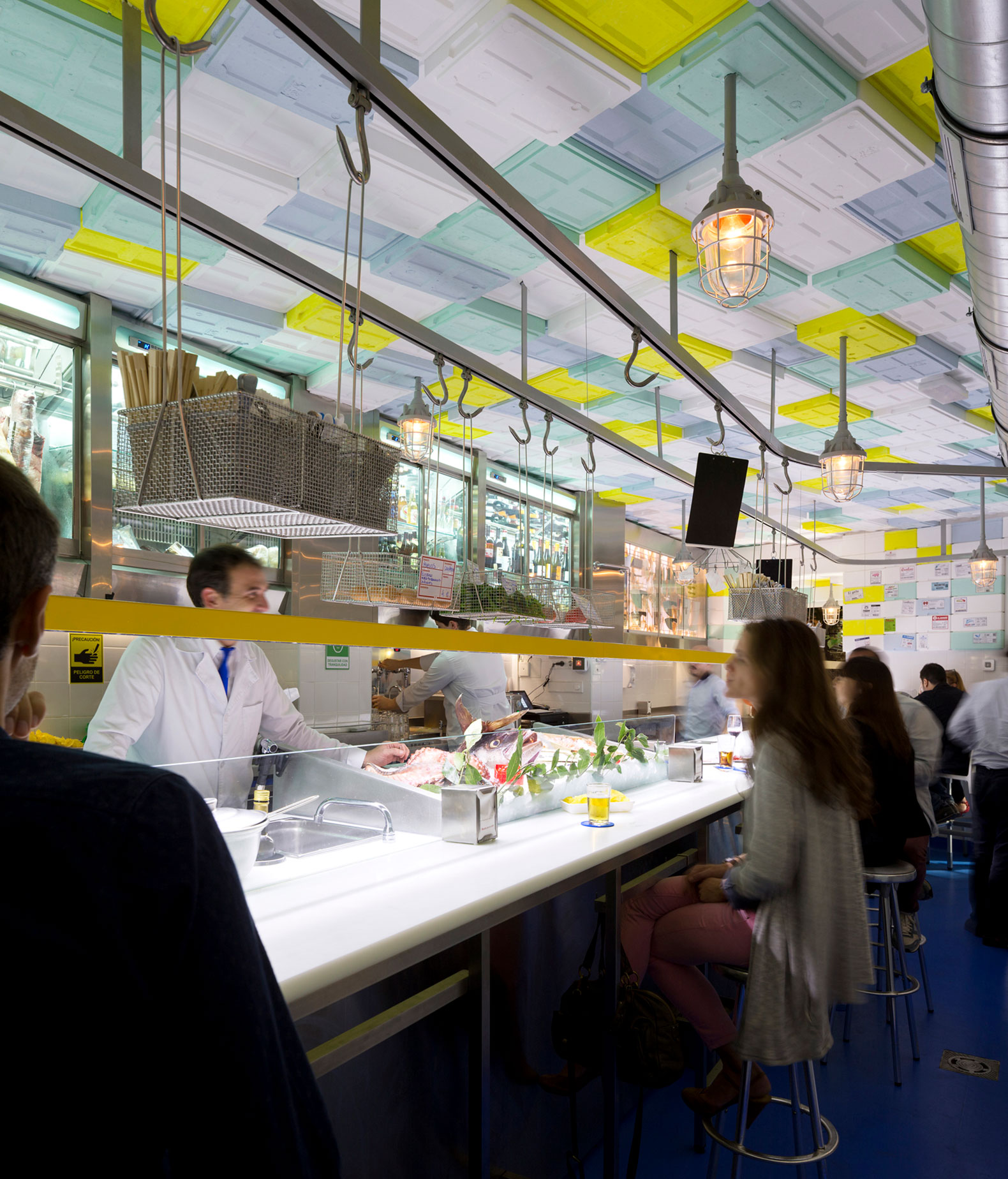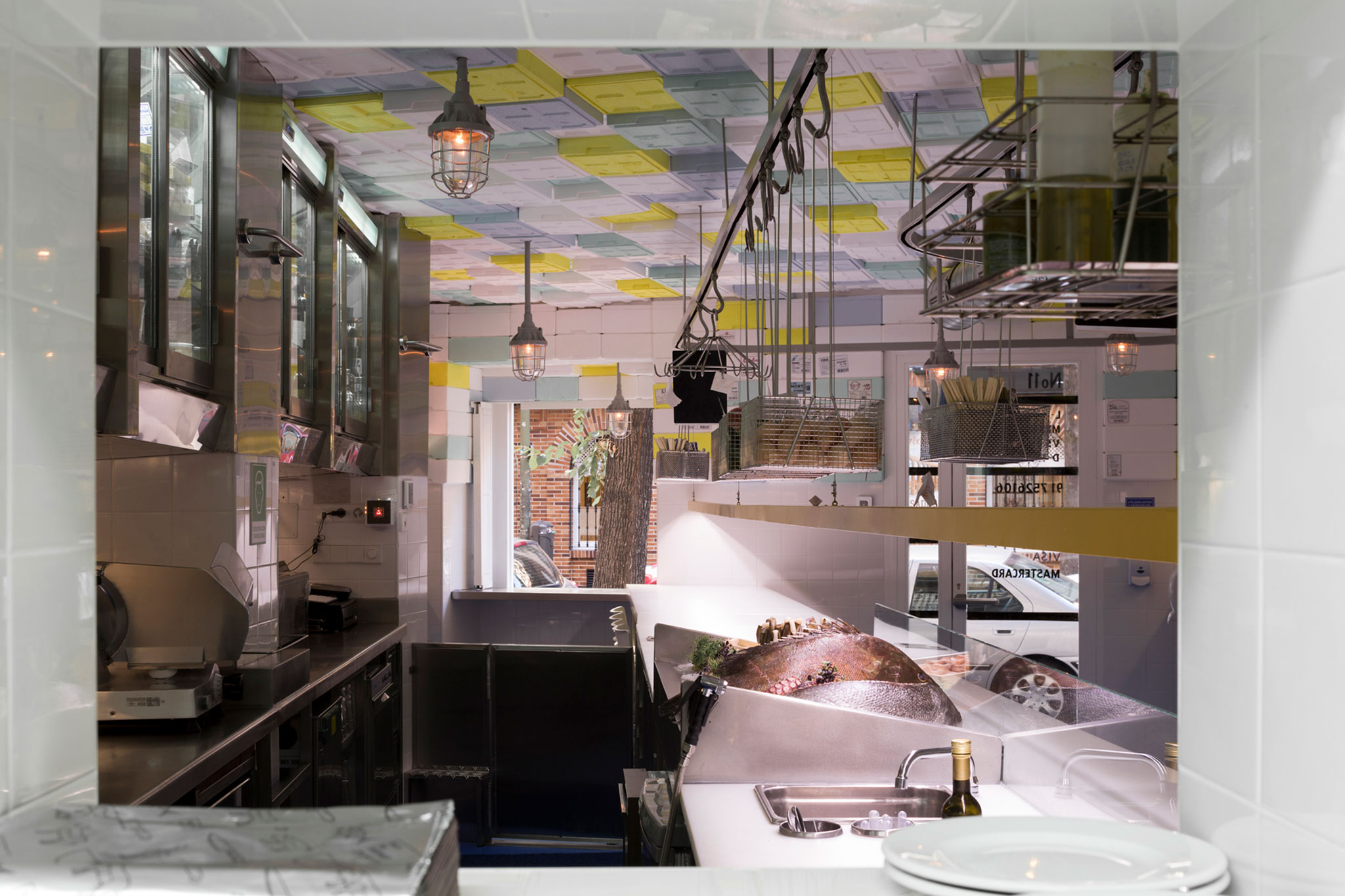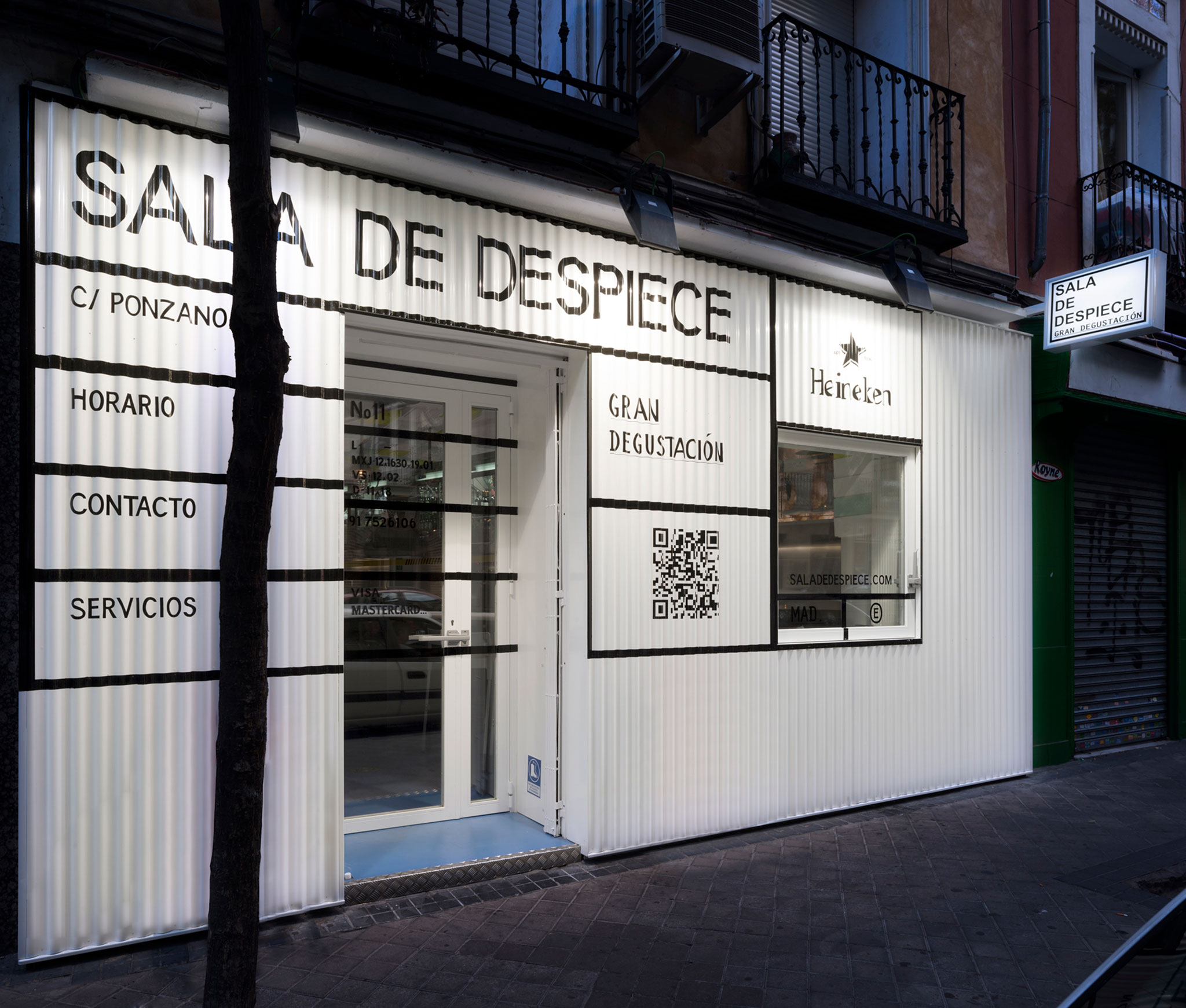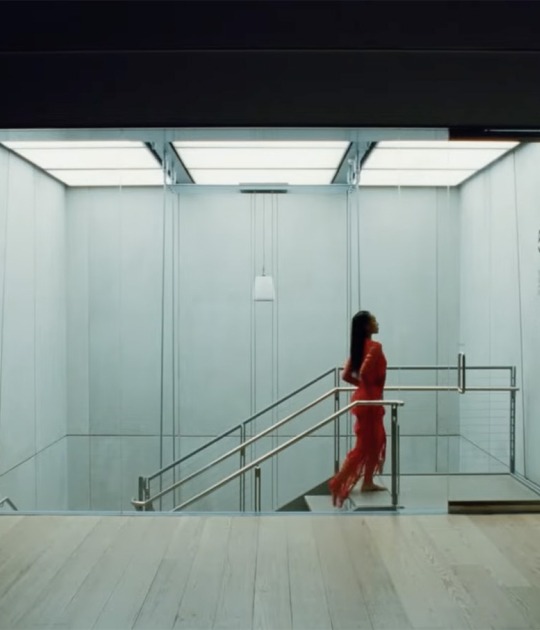The project has a 10-meter white polyethylene cutting board as the main element that functions as a cutting table, food preparation counter, support for displaying the fresh product just received, a bar counter, and, at one end, becomes the only table in the place.
The proposal stands out for its simplicity and effectiveness, being highlighted on the façade of the establishment, a corrugated sheet façade on which the details of the premises were printed in a very austere way.

Sala de Despiece by OHLAB. Photograph by Miguel de Guzmán.
Description of project by OHLAB
Designing the heart of the Sala de Despiece
To start, we wanted to give the design a surprising twist. We chose as a central element a 10-meter white polyethylene cutting board that was going to be the soul of the premises. This table had multiple functions, being a cutting and food preparation point, a bar counter, and even the only table in the establishment. On the ceiling, we installed slaughterhouse guides with sliding hooks, an unusual service that allowed diners and cooks to access cutlery, product lists, condiments, and fresh food.
Creativity in budget austerity
Working with a limited budget-challenged us to be creative in choosing materials. We opted for PVC floors with visible drains and easy-to-clean white tiling. In addition to the aforementioned versatile white polyethylene central table, for the ceiling and the high areas of the walls we used the same expanded polystyrene boxes used to transport fish, which not only kept the budget under control but also became a crucial element that dampened the acoustics in a small, crowded space. Furthermore, the choice of these boxes was made deliberately, in line with the principles of circular economy, giving this object a second life, so that they would not become waste.
Play of light and shadows
Lighting was an essential component in creating the Cutting Room's unique atmosphere. We used a linear white light lamp that intensely highlighted the bar, focusing attention on the food and improving its presentation. On the ceiling, we placed cold room lamps that emitted a soft, scenic light. In addition, next to the bar, four illuminated cold rooms displayed fresh products and drinks, while two backlit display cases displayed an outstanding collection of cutting utensils for meat and fish. Indirect and warm perimeter lighting, hidden behind the polystyrene boxes, completed the warmth of the space.

Sala de Despiece by OHLAB. Photograph by Miguel de Guzmán.
A design adapted to the gastronomic experience
Located on Ponzano Street, one of the most emblematic tapas routes in Madrid, the space was designed without tables to promote an informal, standing-tasting experience. The culinary proposal of the Cutting Room, developed by the promoter and chef, focused on the best quality raw materials, prepared with a simple but impeccable preparation and with an original touch. We tried to understand the gastronomic proposal that the client wanted to promote, as well as the type of product they would use. Some of the most significant references included the food markets and slaughterhouses of Madrid, in addition to MercaMadrid. Finally, we conceived a space in which the authenticity and rawness inherent to these reference places could be breathed.
From the outside
On the façade, we proposed a white corrugated sheet, where the details of the premises were printed, in a very austere way. This choice was not only a matter of aesthetics, but carried with it a statement of design principles: simplicity can be surprisingly effective. At that time, the use of a QR code on a facade was not as common as it is today.
Cutting Academy, an additional independent space
Two years after the opening of the Cutting Room, we designed an additional independent space located in the neighboring building, which would allow it to create an innovative, interactive, and educational gastronomic experience, where diners would become active participants in the preparation of their own dishes.

Sala de Despiece by OHLAB. Photograph by Miguel de Guzmán.
To achieve this vision, we pay meticulous attention to detail and strive to create a groundbreaking visual experience. Our goal was to achieve a harmonious fusion of industrial and contemporary elements, evoking the essence of a slaughterhouse without falling into the sinister. The walls were covered with a quilted reused thermal blanket, obtained from a transport truck, and anchored to the walls using Phillips screws.
The table in question became a design piece specially conceived with thoroughness and a detailed approach. Made from a combination of steel and backlit translucent CORIAN, this table had the surprising ability to "x-ray" food previously cut into thin slices. The piece was designed by the OHLAB team and meticulously manufactured by the Lagares company, which is widely recognized for its precision work.
Throughout the day, the table played the role of a workspace in the kitchen, equipped with all the necessary tools, including washing hoses and storage areas for utensils, as well as a central sink. However, during the night, this versatile table was transformed into a unique dining experience. The central sink became a space filled with ice, ideal for keeping bottles cold. Additionally, a drawer was included for each diner containing utensils reminiscent of surgeon's tools, designed specifically for enjoying the meal. Above each diner, a projector was placed that performed video-mapping on the food itself placed on the table.

Sala de Despiece by OHLAB. Photograph by Miguel de Guzmán.
A cold room was also incorporated that functioned as a showcase, visible from the outside, where the products that were going to be consumed were displayed, adding a striking element and a touch of scenographic drama from the street.
10 years later
After a decade of experience and professional growth, we look back fondly on the Cutting Room. Back then, this project challenged us due to a tight budget, which led us to look for bold solutions. As we continue to work on various projects, including award-winning hotel, residential, and retail projects in Spain and abroad, we value that moment very positively.
Over the years, our work has evolved, and we continue to explore the intersection between creativity, innovative design, and sustainability in every project we undertake. The Cutting Room brought about a series of international recognitions and awards in the world of design and architecture, a path that we followed with passion and dedication.
The legacy of the Cutting Room lies not only in its design but in the lessons it left us. It showed us that simplicity can be surprisingly effective in design, and that design does not necessarily depend on high budgets, but on the clever integration of seemingly simple elements.

Sala de Despiece by OHLAB. Photograph by Miguel de Guzmán.
The choice of circular materials, the play of light and shadows through lighting, and the creation of scenic spaces are elements that have influenced our design vision in subsequent projects.
Finally, seeing that our designs help our clients achieve success gives us great satisfaction and pushes us to continue creating spaces adapted to each era, place, use, and moment every day.



























































